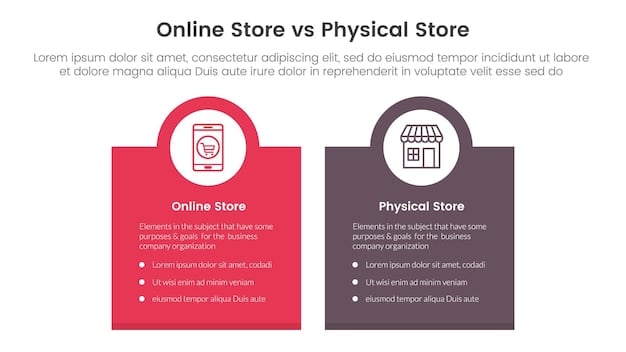Manufacturer Coupons vs. Retailer Coupons: Maximize Your Savings

Manufacturer coupons are issued by the product’s maker, redeemable at various stores, while retailer coupons are specific to a particular store, enhancing savings through strategic stacking for maximum discounts.
Navigating the world of coupons can feel like deciphering a secret code, but understanding the difference between manufacturer coupons vs. retailer coupons can significantly boost your savings.
Understanding Manufacturer Coupons
Manufacturer coupons are offered by the manufacturers of products to incentivize consumers to purchase their specific brands. They can be used at virtually any store that carries the item and accepts coupons.
These coupons are a marketing tool designed to boost sales and can be distributed in various ways, making it essential for savvy shoppers to know where to find them.
Where to Find Manufacturer Coupons
Manufacturer coupons can appear in a variety of formats and places. Knowing where to look increases your chances of finding valuable savings.
- Sunday Newspaper Inserts: Traditionally, the Sunday newspaper is a treasure trove of manufacturer coupons. Brands often include coupon inserts like SmartSource, RetailMeNot, and P&G.
- Online Coupon Websites: Websites such as Coupons.com, SmartSource.com, and P&G Good Everyday offer digital manufacturer coupons that can be printed or loaded directly to your store loyalty cards.
- Product Packaging: Keep an eye on product packaging. Many manufacturers print coupons directly on their packages or include them inside.
- Mobile Apps: Apps like the Coupons.com app and those from specific brands often provide digital coupons that you can activate and use at checkout.

Manufacturer coupons provide a great way to save across multiple retailers and can often be combined with other savings strategies.
Deciphering Retailer Coupons
Retailer coupons, on the other hand, are issued by specific stores and can only be used at those particular locations. These coupons are intended to drive traffic to the store and encourage purchases of particular items.
They often reflect a store’s specific marketing strategy, promotional campaigns, or efforts to clear out inventory.
How Retailer Coupons Work
Retailer coupons can be found in several forms and have specific terms of use that shoppers need to understand to maximize savings.
- Store Flyers: Many retailers distribute weekly or monthly flyers through the mail or at the store. These flyers often include coupons for specific products or general discounts, such as a percentage off your entire purchase.
- Store Apps: Most major retailers have their own mobile apps that offer digital coupons. These are often personalized based on your shopping history and preferences.
- Email Newsletters: Subscribing to a store’s email newsletter is a great way to receive exclusive coupons and promotional offers. Retailers frequently send out coupons as a reward for loyalty or to announce special sales events.
- In-Store Promotions: Retailer coupons can sometimes be found in-store, either at the entrance, near specific products, or at the checkout counter. These are often spontaneous promotions to encourage immediate purchases.
Retailer coupons are useful for saving money on products you regularly purchase from a specific store, helping to build brand loyalty and encourage repeat visits.
Key Differences: Manufacturer vs. Retailer Coupons
Understanding the fundamental differences between manufacturer and retailer coupons is crucial for maximizing your savings potential. These differences influence where you can use the coupons, what you can buy, and how they can be combined.
The primary differences revolve around source, usage, and combining possibilities.
Source and Distribution
Manufacturer coupons are issued by the brand or manufacturer of the product, while retailer coupons are issued by the store where you are shopping. This simple distinction dictates their usage.
Usage and Redemption
Manufacturer coupons can generally be redeemed at any store that accepts coupons, provided the store sells the item. Retailer coupons are specific to a particular store or chain and can only be used there.

Combining Coupons
One of the most significant differences is the ability to combine these coupons. In many cases, you can “stack” a manufacturer coupon with a retailer coupon on a single item, amplifying your savings. However, this depends on the store’s coupon policy, so it’s essential to check the details.
Knowing these distinctions can help you strategize your shopping trips effectively, ensuring you get the best possible deal on every purchase.
Maximizing Savings with Coupon Stacking
Coupon stacking is a strategic technique that involves combining multiple coupons on a single item to maximize savings. This is a powerful method for reducing your overall expenses.
While not all stores allow coupon stacking, understanding how and when to use it can lead to significant savings.
Understanding the Rules of Coupon Stacking
Before attempting to stack coupons, it’s critical to understand the coupon policies of the stores where you shop. Here are some general guidelines to keep in mind:
- Read the Fine Print: Always read the terms and conditions on each coupon. Look for phrases like “one coupon per purchase” or “cannot be combined with other offers.”
- Check Store Policies: Many stores have specific coupon policies posted in-store or on their website. Familiarize yourself with these policies to ensure you are following the rules.
- Know Your Limits: Some stores limit the number of coupons that can be used on a single transaction or per item. Be aware of these limits to avoid disappointment at the checkout.
Strategies for Effective Coupon Stacking
Effective coupon stacking requires careful planning and a bit of organization. Here are some strategies to help you make the most of this technique:
- Plan Your Shopping List: Before heading to the store, create a detailed shopping list. Identify items you need and search for both manufacturer and retailer coupons for those products.
- Organize Your Coupons: Keep your coupons organized by expiration date and product category. Use a coupon organizer or app to easily find the coupons you need while shopping.
- Combine Strategically: Pair manufacturer coupons with retailer coupons for the same item whenever possible. Look for sales or promotions that can be combined with your coupons for even greater savings.
Combining coupons effectively requires attention to detail, but the savings can be well worth the effort, especially on items you buy regularly.
Navigating Store Coupon Policies
Every store has its own unique coupon policies, and understanding these policies is crucial for successful couponing. Knowing the rules ahead of time can prevent misunderstandings and maximize your savings.
It’s important to familiarize yourself with the specific guidelines of the stores you frequent to avoid issues at checkout.
Key Elements of Store Coupon Policies
Store coupon policies typically cover several key areas, including:
- Coupon Acceptance: Does the store accept both manufacturer and retailer coupons? Are there restrictions on printable coupons or digital coupons?
- Coupon Stacking: Does the store allow coupon stacking? If so, are there any limits on how many coupons can be combined per item or transaction?
- Expiration Dates: How does the store handle expired coupons? Some stores may have a grace period, while others strictly adhere to expiration dates.
- BOGO Offers: How does the store handle coupons in conjunction with Buy One Get One (BOGO) offers? Can you use a coupon on both the purchased item and the free item?
Tips for Staying Informed
Staying up-to-date on store coupon policies is an ongoing process. Here are some tips to help you stay informed:
- Check the Store Website: Most stores have their coupon policies posted on their website. Review this information regularly, as policies can change over time.
- Ask Customer Service: If you have questions about a store’s coupon policy, don’t hesitate to ask a customer service representative for clarification.
- Join Online Communities: Participate in online forums or social media groups dedicated to couponing. These communities are a great source of information and can provide updates on policy changes.
By understanding and staying informed about store coupon policies, you can avoid surprises at the checkout and maximize your savings potential.
| Key Point | Brief Description |
|---|---|
| 🏷️ Manufacturer Coupons | Issued by manufacturers, redeemable at most stores. |
| 🏢 Retailer Coupons | Issued by specific stores, valid only at that retailer. |
| ➕ Stacking | Combines manufacturer and retailer coupons for extra savings. |
| 📜 Store Policies | Understanding each store’s unique rules is crucial. |
Frequently Asked Questions
▼
Manufacturer coupons are issued by the product’s maker and can be used at various stores, while retailer coupons are specific to a particular store and can only be used there.
▼
Yes, in many cases, you can stack both a manufacturer and retailer coupon on the same item, but always check the store’s coupon policy to ensure it is allowed.
▼
Manufacturer coupons can be found in Sunday newspaper inserts, online coupon websites, product packaging, and mobile apps.
▼
You can find a store’s coupon policy on their website, or by asking a customer service representative in the store if you have additional questions.
▼
Politely ask to speak to a manager, and if they still refuse after explaining your coupon meets their policy requirements, consider shopping elsewhere, as policy adherence is important.
Conclusion
Understanding the nuances between manufacturer and retailer coupons empowers you to make informed decisions, maximize your savings, and become a savvy shopper. With careful planning and attention to detail, you can significantly reduce your expenses and enjoy the benefits of strategic couponing.





